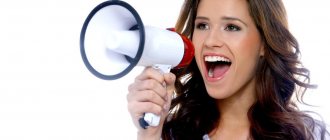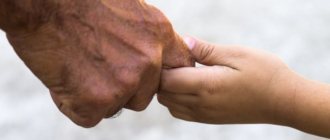Seconds to create a first impression
The psychology of nonverbal communication is too multifaceted to cover it all. Let's consider how to learn about a person's character from a first impression. Psychologists say that in the first 10 seconds of communication, an impression of the interlocutor is already created. A person can say one thing with words, but facial expressions, intonation, and gestures can tell something completely different.
A person controls words, but gestures are difficult to control. The body can't lie! Therefore, in order to find out the truth about your interlocutor, you need to learn to understand his gestures.
An individual may completely forget to monitor gestures and facial expressions when his emotional mood increases. Therefore, psychologists try to ask awkward questions in order to confuse the subject.
During dialogue, special attention should be paid to the position of the hands
- The first thing you always want to know is whether you are being deceived or not. Touching your face will tell you this. If your opponent constantly touches his face, neck, ears, most likely he is telling a lie, simply deceiving you.
- A lie can be revealed by movements when you involuntarily cover your mouth with your hand. When lying, the interlocutor gets nervous, so it’s as if he’s trying to hold back untruthful words with his hand. This habit comes from childhood, when a child who has told a lie covers his mouth with his palm.
- Hand movements near the mouth most likely demonstrate that the interlocutor lacks support or approval.
- A calm posture, with the chin slightly raised, indicates the person’s confidence in his words. He's not lying, you can be sure of that.
- Hands clasped in front of your body indicate that you are not trusted. In this case, a person can cover himself with a folder, a stack of papers, or cross his arms. Crossed arms are the first sign that you are not trusted. It is important to understand what caused it, why the interlocutor does not want to open up. If you are to blame, then “dig” into your behavior.
- If a person opens his palms when meeting, then he is open to communication.
- An aggressive mood can be indicated by hands placed in pockets, while the thumbs remain outside.
- People who clasp their hands behind their backs show their superiority over others. Their ego "flies" too high.
- When the interlocutor is upset about something and tries to pull himself together, he will start scratching the tip of his nose.
What does fig mean?
“Kukish”, fig, dulya, shish - all this refers to a well-known meaning - you will not get anything. In this case, three fingers are involved: the thumb is inserted between the index and middle fingers. In Rus', such a symbol was used to scare away evil spirits. And even today, when meeting with ill-wishers, many keep a fig in their pocket.
But a long time ago in Rus' this “construction” meant sexual intercourse. It's a different matter in Brazil. The gesture is considered a talisman that attracts good luck by protecting against the black eye.
If you see a fig in Japan and Thailand, you can interpret it this way: you are being offered an extensive list of sexual services.
How to find out about a person's location
When communicating, you should carefully look at the position of your opponent’s body. When communicating with someone around you, you always want to find mutual understanding. How to catch: is it there or not? During harmonious communication, the partners’ postures are very similar. From time to time, both repeat each other's gestures.
How to spot opposition? It manifests itself in pushing one shoulder forward. An obvious confrontation is clenching your fists and putting your feet forward. When demonstrating non-acceptance of your arguments, the interlocutor puts his hands on his sides.
Youth hand gestures and their meaning
Our children also use sign language for their communication, and the variety of these non-verbal signs is constantly enriched by the emergence of new ones. Let's give a few examples of such youth gestures, with the help of which teenagers can easily understand each other, while older people, and even middle-aged people, will remain in the dark.
Time and scientific and technological progress dictate their conditions, and this fully applies to our gestures.
Just recently, a hand folded in the shape of an English L did not mean anything, but today it is a loser, a sign signaling that you are a loser.
An extended middle finger pointing to the side can mean that you are being sent, but at the same time it can be interpreted as an invitation to sex.
With your fingers shaped like a heart, it’s simple: “I love you.” But a “horned goat” with its thumb pointed to the side means simple sympathy.
An English V performed by a teenager with the back of his hand turned towards you can mean two Colas, or serve as the equivalent of a middle finger in the UK. And such a familiar sign as OK, but inverted, and shown at waist level or below, is an open invitation to sex.
Thanks to the specific versatility of using hand language and a few widely spoken English words, you can communicate with a foreigner you meet by chance on a busy street. Of course, you won’t be able to conclude a contract with him for the supply of gas equipment, but you can easily explain how to get to the nearest metro station or stadium.
Bride ransom competitions: cool and fun options are in our publication on the website.
You can learn about table competitions for a fun company from this article.
From here you will learn a lot of interesting things about the longest day of the year.
How does a person express disagreement?
How do you know if a person is ready or not ready to have a conversation?
If you see that a person is leaning slightly in your direction, it means he wants to speak. The cross-leg position will “express” disagreement with your arguments. Expect to enter into an argument if you are not convinced that you are right. Try to open your palms, you will immediately notice how your interlocutor softens.
Disagreement can also be expressed by the following gestures:
- Hands are clasped.
- Arms crossed on chest.
- Withdrawal from communication shows a backward deviation of the back.
- Crossed legs at the ankles is a call to stop communication.
If the legs are straight, relaxed, and the torso is turned towards the partner, then the opponent is completely ready to conduct a conversation.
What poses will reveal hidden thoughts?
To “read” hidden thoughts in your partner’s behavior, you can resort to some tricks.
The most effective trick is to get into his personal space. Changing the distance is used by executives, investigators, and police officers. At the same time, the person gets lost, then begins to express what he would not like to say. An individual who is convinced that he is right will never flinch from such an action. The liar will begin to touch his neck, ears, close his mouth, blush, and turn pale.
Readiness for action is demonstrated by placing your hands on your hips. This gesture shows that the person intends to go towards his goal.
A person's appearance is very important. An unbuttoned jacket or jacket shows the friendliness of the partner. If he is buttoned up, has his hands in his pockets or crosses them over his chest, then he is not ready to make a deal or sign an agreement. So that your partner is not “afraid” of you, you should show your palms. Then the conversation will flow in a different direction and an agreement will be concluded.
A partner who sits but has his legs out shows his openness. If your opponent is bored listening to you, he begins to draw abstract figures on a piece of paper. He can stand up, supposedly behind a book or pen. Turning your face to the side is a demonstration of disinterest in the conversation. You will see your hands tightly clasped - this is a gesture of suspicion and mistrust.
Slap on the throat
This gesture from the Russian drinking tradition articulated the phraseological phrase “pawn for the tie”, widespread in the 19th and early 20th centuries. This expression was born among officers, and it was invented by a certain Colonel Raevsky, “a talker and a buffoon.” By the way, he “invented” another “drinking” phrase - a little podshefe (chauff?). Interestingly, this gesture was adopted by speculators of strong drinks during the Prohibition Law, which Nicholas II established in the Russian Empire in 1914.
How to recognize a dominant person
Often a person begins to show his superiority. Why did it happen? He asserts himself or is arrogant or shows his power.
How to recognize such a person:
- At the first handshake. He grabs the other person's hand so that his hand is on top.
- Feet on the table or on the armrest of a chair.
- Hands joined behind the head.
- Half-closed eyelids.
- Hands in pockets with thumbs out.
- Sits higher than others or stands so that the interlocutor looks into his face from below.
- The pose of senior managers is with hands behind the back, chin looking up.
A rare but interesting position for a person - hands under the armpits, and the torso slightly tilted back. This is how the individual demonstrates confidence in his actions.
Edge of palm on table
The gesture when a person places the edge of his palm on the table is, as a rule, authoritative. A person “fights off” his decision and is unlikely to change it.
This can often be used as a way to get your point across. If you use this gesture, just don't be too aggressive.
A resident of Germany called Sputnik V the best drug in existence
Inscriptions and emoticons: the latest printed manicure options for spring 2021
“My great-grandchildren will pay the bill!”: three Jewish jokes about money
How your feet tell you what you're thinking
Watch where your feet stand. A knowledgeable person will quickly read your thoughts. Why legs? You can still control your arms, but your legs rise on their own, depending on your intentions.
- Wide-set legs show off the groin. This is how men can stand in front of their chosen one. Experts assure that you can rely on such a man. He stands confidently on the ground. For those around him, this is a signal that he is a ruler and never runs away from difficulties. Hands that rest confidently on the belt buckle help enhance the effect.
- The toe of one foot is turned to the side. The pose indicates where the person wants to go. If you are engrossed in a conversation, and the other person’s toe is looking to the side, then don’t hold on, let him go. There won't be a good conversation anyway!
- If the socks are pointing in your direction , then the person is interested in talking longer.
- If a person is uncomfortable in an unfamiliar company, then he will stand to the side with his legs crossed . Please note that if he also crosses his arms over his chest, then he has completely closed himself off from everyone.
- If a person grabs his leg with his hands , then he does not intend to retreat. He will stand his ground.
- When a person starts “kicking” the air with his foot , he is about to tell you to leave.
- Grasping the leg with both hands shows that the person will not deviate from the intended path.
- Crossed legs, sitting and standing, demonstrate one thing - closedness or severe stress. At this time, no information reaches him.
- If a person crosses his legs at the ankles, and even puts them under a chair , then the person is extremely uncomfortable because he cannot drive you away. Knowing this gesture, you should leave. In this state, the individual will also not be able to perceive information.
Dear friends, the conversation on the topic: “What do human postures mean” is so interesting and useful that it can captivate you. Being able to decipher poses is useful for business partners, managers and just friends, so that they know what to expect from their interlocutor.










